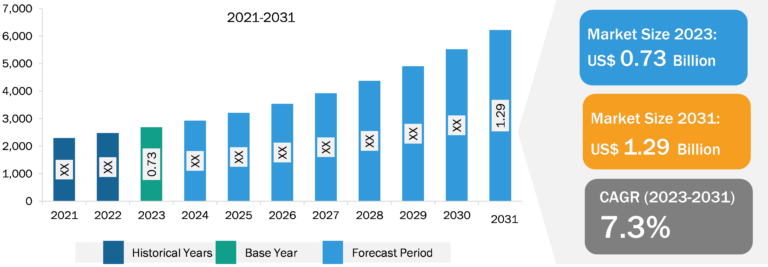
Green Hydrogen Market
The establishment of large-scale green hydrogen plants attracts significant investments from both the public and private sectors. In June 2023, a group of companies announced their plan to invest US$ 79.75 in a project for the development of a hydrogen production facility and a hydrogen liquefaction facility in Queensland, Australia. The group of companies includes Iwatani Corporation (Japan), Kansai Electric Power Company (Japan), Marubeni Corporation (Japan), Keppel Infrastructure (Singapore), and Stanwell Corporation (Australia). Moreover, other countries have also announced their respective plans to produce green hydrogen to achieve their respective zero-emission targets which is another major factor likely to provide future growth opportunities for green hydrogen market players across different regions. In addition, the green hydrogen market is also likely to witness the new players coming forward to compete in such emerging markets and make their contributions towards a sustainable future.

Large-sized green hydrogen plants require dedicated infrastructure, including hydrogen production facilities, storage systems, and transportation networks. The establishment of such plants drives the requirement for a robust infrastructure that supports the distribution and utilization of green hydrogen and also contributing to the green hydrogen market growth across different regions. For instance, in June 2023, Larsen & Toubro announced its plan to set up infrastructure for the world’s largest green hydrogen plant in Saudi Arabia, which is being built by NEOM Green Hydrogen Company (NGHC). Thus, a rise in infrastructure development is expected to create a favorable environment for the adoption of green hydrogen in different sectors, which is likely to offer growth opportunities to the green hydrogen market players during the forecast period.
Moreover, on May 30, 2030, the Indian Ministry of Power announced a complete waiver of the interstate transmission systems (ISTS) charges on offshore wind, green hydrogen, and ammonia project for 25 years. This waiver applies to projects commissioned till December 31, 2032. With the expansion of offshore wind and other renewables, the opportunities to produce and store clean hydrogen are also expected to grow in the coming years. Clean hydrogen can help nations meet energy demands in the coming years. Therefore, the production of green hydrogen from wind energy is expected to accelerate with the rise in renewable energy deployment and an upsurge in demand for clean and sustainable energy solutions. Green hydrogen can potentially contribute to decarbonizing various sectors and play a significant role in transitioning to a low-carbon economy. This is propelling the green hydrogen market growth.
Green Hydrogen Market: Industry Overview
The US Department of Energy (DOE) is actively involved in promoting research and development across various technologies aimed at achieving economically viable and net-zero-carbon pathways for hydrogen production. The primary issue faced in hydrogen production is the capital required for the process. To address this challenge, the DOE’s Hydrogen and Fuel Cell Technologies Office is committed to developing new technologies that can produce hydrogen at US$ 2 per kilogram by 2026 and further reduce it to US$ 1 per kilogram by 2031, all through net-zero-carbon processes. These efforts align with the Hydrogen Energy Earthshot initiative, which seeks to reduce the cost of clean hydrogen by 80% within a decade, making it available at an affordable rate of US$ 1 per kilogram. By driving these developments, the DOE aims to accelerate the adoption of hydrogen as a clean and cost-effective energy solution in the future which is expected to boost the green hydrogen market size during the near future. For instance, in January 2023, the US Department of Energy (DOE) announced a Funding Opportunity Announcement (FOA) in response to the Infrastructure Investment and Jobs Act (IIJA), commonly known as the Bipartisan Infrastructure Law (BIL). This initiative involves an investment of US$ 8 billion to facilitate the establishment of Regional Clean Hydrogen Hubs (H2Hubs). These H2Hubs will serve as critical centers for showcasing the entire clean hydrogen value chain, encompassing production, processing, delivery, storage, and end-use applications. The overarching objective is to support the Biden Administration’s ambitious targets of achieving a carbon-free electric grid by 2035 and transitioning to a net-zero emissions economy by 2050. Through this funding, the DOE aims to accelerate advancements in hydrogen technology and infrastructure, driving toward a more sustainable environment. Such initiatives are likely to catalyze the green hydrogen market size in the near future.







